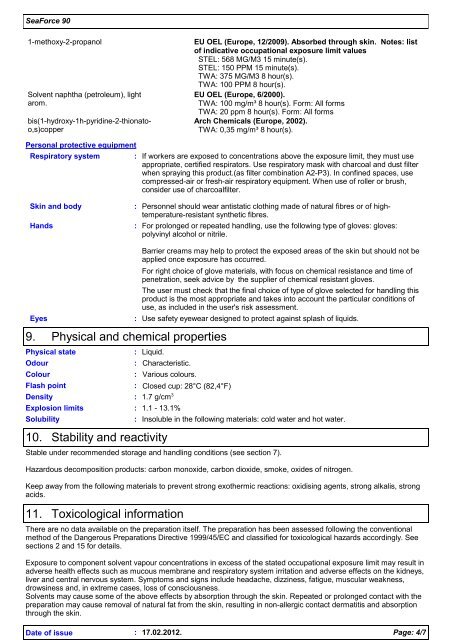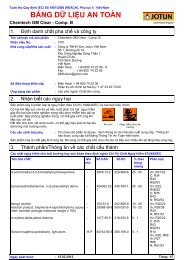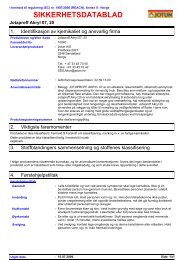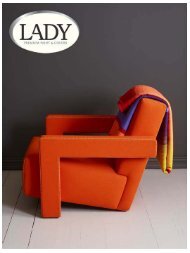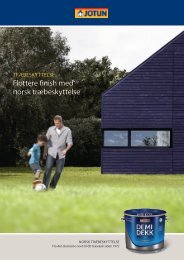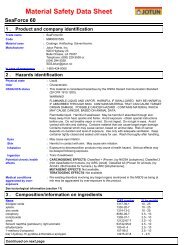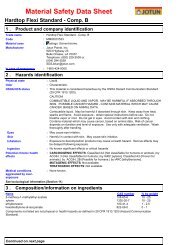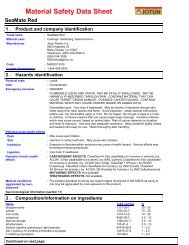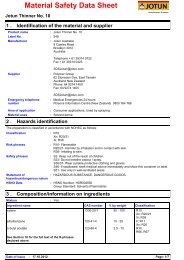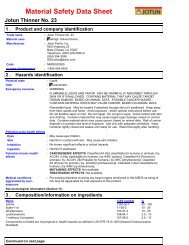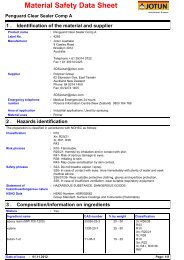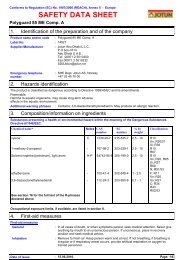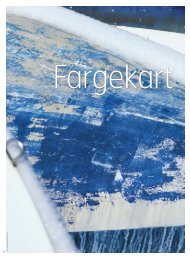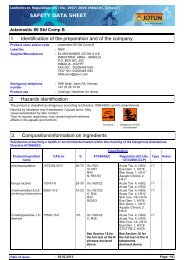SeaForce 90 - Marine_Protective - English (uk) - Jotun
SeaForce 90 - Marine_Protective - English (uk) - Jotun
SeaForce 90 - Marine_Protective - English (uk) - Jotun
- No tags were found...
You also want an ePaper? Increase the reach of your titles
YUMPU automatically turns print PDFs into web optimized ePapers that Google loves.
<strong>SeaForce</strong> <strong>90</strong>1-methoxy-2-propanolSolvent naphtha (petroleum), lightarom.bis(1-hydroxy-1h-pyridine-2-thionatoo,s)copperEU OEL (Europe, 12/2009). Absorbed through skin. Notes: listof indicative occupational exposure limit valuesSTEL: 568 MG/M3 15 minute(s).STEL: 150 PPM 15 minute(s).TWA: 375 MG/M3 8 hour(s).TWA: 100 PPM 8 hour(s).EU OEL (Europe, 6/2000).TWA: 100 mg/m³ 8 hour(s). Form: All formsTWA: 20 ppm 8 hour(s). Form: All formsArch Chemicals (Europe, 2002).TWA: 0,35 mg/m³ 8 hour(s).Personal protective equipmentRespiratory system :If workers are exposed to concentrations above the exposure limit, they must useappropriate, certified respirators. Use respiratory mask with charcoal and dust filterwhen spraying this product.(as filter combination A2-P3). In confined spaces, usecompressed-air or fresh-air respiratory equipment. When use of roller or brush,consider use of charcoalfilter.Skin and bodyHands::Personnel should wear antistatic clothing made of natural fibres or of hightemperature-resistantsynthetic fibres.For prolonged or repeated handling, use the following type of gloves: gloves:polyvinyl alcohol or nitrile.Eyes9.Physical stateOdourColourFlash pointSolubility:Physical and chemical propertiesBarrier creams may help to protect the exposed areas of the skin but should not beapplied once exposure has occurred.For right choice of glove materials, with focus on chemical resistance and time ofpenetration, seek advice by the supplier of chemical resistant gloves.The user must check that the final choice of type of glove selected for handling thisproduct is the most appropriate and takes into account the particular conditions ofuse, as included in the user's risk assessment.Use safety eyewear designed to protect against splash of liquids.Liquid.Characteristic.Various colours.Density : 1.7 g/cm 3Explosion limits : 1.1 - 13.1%10.Stability and reactivity:::::Closed cup: 28°C (82,4°F)Insoluble in the following materials: cold water and hot water.Stable under recommended storage and handling conditions (see section 7).Hazardous decomposition products: carbon monoxide, carbon dioxide, smoke, oxides of nitrogen.Keep away from the following materials to prevent strong exothermic reactions: oxidising agents, strong alkalis, strongacids.11.Toxicological informationThere are no data available on the preparation itself. The preparation has been assessed following the conventionalmethod of the Dangerous Preparations Directive 1999/45/EC and classified for toxicological hazards accordingly. Seesections 2 and 15 for details.Exposure to component solvent vapour concentrations in excess of the stated occupational exposure limit may result inadverse health effects such as mucous membrane and respiratory system irritation and adverse effects on the kidneys,liver and central nervous system. Symptoms and signs include headache, dizziness, fatigue, muscular weakness,drowsiness and, in extreme cases, loss of consciousness.Solvents may cause some of the above effects by absorption through the skin. Repeated or prolonged contact with thepreparation may cause removal of natural fat from the skin, resulting in non-allergic contact dermatitis and absorptionthrough the skin.Date of issue : 17.02.2012.Page: 4/7


